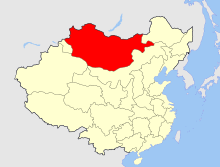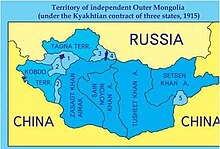Outer mongolia
Outer Mongolia was a territory of the Qing dynasty (1691-1911) ruled by the Manchus. Its area was roughly equivalent to that of the modern state of Mongolia, which is sometimes called "Northern Mongolia" in present-day China, plus the Russian republic of Tuva. While Outer Mongolia administratively only consisted of the four jalja aimags (Setsen Khan, Tüsheet Khan, Sain Noyon Khan and Zasagt Khan), although by the end of the Qing period the term "Northern Mongolia" also used to refer to khalja more to the Oirats of Khovd and the protectorate of Tannu Urianjái (simplified Chinese, 唐努乌梁海).
The name "North Mongolia" contrasts with "South Mongolia", which corresponds to the Inner Mongolia Autonomous Region of the People's Republic of China. The name "Outer/Inner" reflects a Sino-centric perspective that labels the northern part of Mongolia as "Outer", while the southern part, closer to the Chinese capital, is labeled as "Inner".
South Mongolia got its name because it was more directly administered by the Qing court; northern Mongolia (which is farther from the capital, Beijing) had a greater degree of autonomy within Qing rule. The term ar Mongolian (or in simplified Chinese, 漠北蒙古; pinyin, Mòběi Měnggǔ; literally, 'North Mongolian desert') sometimes used in Mongolian language (or Chinese) to refer to Northern Mongolia when making a distinction with Southern Mongolia, to circumvent the history of Qing rule and rather imply a geographic unity or distinction of Mongol-inhabited regions on the Mongolian plateau. Also can be used to refer to Mongolia synchronously. In the Mongolian language, the word ar refers to the back side of something, which has been extended to mean the north side of any spatial entity, for example a mountain or a yurt. The word öbür refers to the southern (and therefore protected) side of a mountain. So, the difference between the northern and southern Mongolias is conceived in the metaphor as the northern side versus on the south side of a mountain. Unlike the one in Chinese, 漠北蒙古, there is also in Chinese, 漠南蒙古; pinyin, Mònán Měnggǔ; literally, 'South Mongolian desert', roughly referring to the region now known as Inner Mongolia.
Today, "Northern Mongolia" it is sometimes still used informally to refer to Mongolia. Outer Mongolia is also used quite often in Taiwan. To avoid confusion between the sovereign nation of Mongolia and China's Inner Mongolia, but to recognize Mongolia's sovereignty, the media in China generally refer to the former as the "State of Mongolia" (in simplified Chinese, 蒙古国; pinyin, Ménggǔ Guó, which is the translation of the official name of said country in Mongolian, Монгол Улс/Mongolian Uls) instead of just "Mongolia" (in Chinese, 蒙古; pinyin, Ménggǔ), which could refer to the entire area of Mongolia.
Jebtsundamba Khutughtu was the spiritual leader of Outer Mongolia.
Composition
Outer Mongolia was one of the political divisions of the Qing Empire. It consisted of four aimags —provinces— (ordered from west to east):
- Setsen Kan (Tsetsen Han Aymag)
- Tüsheet Kan (Tösheet Han Aymag)
- Sain Noyon Kan (Sayn Noyon Aymag)
- Zasagt Kan (Jasagt Han Aymag)
Contenido relacionado
834
688
1389



